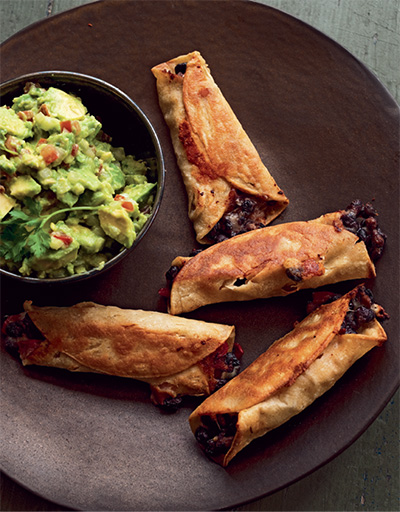
Guacamole and Fake-Out Flautas (page 117)
Chapter Four
makes 2 cups

Guacamole and Fake-Out Flautas (page 117)
Store-bought guacamole mystifies me. Why buy something that simply requires mashing up a few items? And the homemade version is so much better. There are many riffs on guacamole these days, with various vegetables, fruits, or smoked chorizo added to personalize and differentiate them. But my old-school preference is for this version: it was the first Mexican recipe I learned. My early training in Mexican cooking came from Diana Kennedy, an absolute purist author-teacher of authentic regional Mexican food.
¼ cup finely chopped white onion
2 serrano chilies, minced (about 2 tablespoons)
3 tablespoons chopped fresh cilantro
1 teaspoon coarse salt
3 ripe Hass avocados, halved, pitted, and flesh scooped out of skin
1 small tomato, chopped
Tortilla chips, warm tortillas, or flautas for serving
makes 12 flautas; serves 6
When I first made these at home, the fam asked if I’d ordered from the local taqueria. Talk about a coup! Flautas are those addictive deep-fried skinny tacos. This version became a total repeat-recipe hit. I call them “fake-out” because unlike their messy, deep-fried cousins, they are a quick low-fat, baked, vegetarian gem of a recipe. Serve with Guacamole, the ultimate scoopable flavor bomb.
12 corn tortillas
6 ounces Monterey Jack cheese, grated
2 tomatoes, chopped
One 15-ounce can black beans, drained and rinsed
½ teaspoon coarse salt
Juice of ½ lime
1 tablespoon safflower or other vegetable oil
Melty Gooey Snack
serves 2
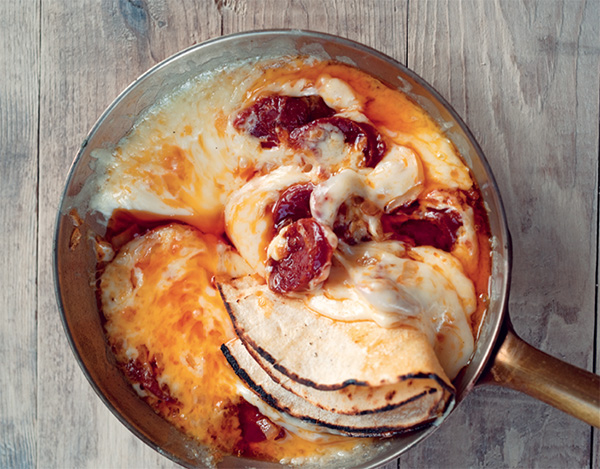
There are few things more divinely swoon-worthy than this concoction, which should almost be labeled an illegal substance. Queso fundido is insanely easy to replicate at home, and you’ll be spared any cleanup hassle, because every last bit of the crispy cheese that crusts up at the bottom of the pan will be scraped up and devoured. Serve with tortillas and Roasted Salsa Verde (page 211).
4 ounces smoked chorizo, cut into ¼-inch pieces
½ small yellow onion, finely chopped
12 ounces Monterey Jack cheese, shredded
Eight 6-inch corn tortillas, warmed over a flame (see Note)
makes 2 cups
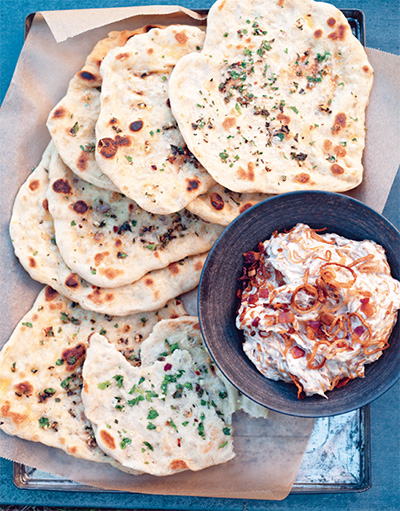
Herb Flatbreads (page 122) and Caramelized Onion and Bacon Dip
If you love yet hate that packaged onion soup mix dip, this is the version for you. It is a richer, deeper-flavored, cleaner-ingredient excuse for a potato-chip-dipping marathon. Or smear it over Herb Flatbreads (page 122) for a classier affair. For a sip with your dip, try Grapefruit Thyme Cocktail (page 245). The dip can be refrigerated for up to 3 days.
¼ cup extra virgin olive oil
3 pounds yellow onions, halved lengthwise and thinly sliced crosswise
1 teaspoon coarse salt
2 tablespoons white wine vinegar
⅓ pound bacon, chopped
1½ cups mayonnaise
1 cup sour cream
Optional Garnish
¼ cup safflower oil
3 shallots, thinly sliced into rings
makes twelve 6-inch flatbreads
Pizza-parlor dough is a quick road to a “home-baked” bread. For these flatbreads, just portion out the dough, roll into balls, stretch into rounds, season, and char on both sides: this can be done in a cast-iron skillet or other heavy pan or on the grill. Try serving the flatbreads with Caramelized Onion and Bacon Dip (page 120).
1 pound pizza dough—thawed frozen store-bought or from the pizza parlor
Extra virgin olive oil for rolling the dough
2 garlic cloves, minced
2 tablespoons finely chopped fresh parsley
1 tablespoon finely chopped fresh oregano
2 teaspoons flaky sea salt, such as Maldon, or coarse salt
⅛ teaspoon red pepper flakes
makes 12 potato skins
When my oldest son, Calder, went off to college, I was a little nervous about how he would fare foodwise. My suspicions were realized by the first culinary report I got describing the previous night’s “amazing” dinner—take-out chicken wings and delivery pizza. I thought living off this type of food sounded disgusting but tried my best to understand his newfound habits—and I realized that even though college students can hardly be considered to have discriminating palates, they’re onto something. Familiar foods that make us happy transport us back to our earliest tastes of deliciousness, memories often associated with pleasure and peace. So I started making this sort of recipe whenever he came home, based on ingredients like chicken and potatoes. Needless to say, this potato-based dish is hedonistically delicious, and only an active someone the age of a college student could handle a steady diet of these calories.
6 large russet (baking) potatoes (about 3½ pounds), scrubbed
6 slices bacon
⅓ cup extra virgin olive oil
1 teaspoon coarse salt
¼ teaspoon white pepper
4 ounces sharp white cheddar cheese, shredded
4 ounces Monterey Jack cheese, shredded
1 cup sour cream
¼ cup chopped fresh chives
Wing Weakness
serves 4 normal people or 2 college students
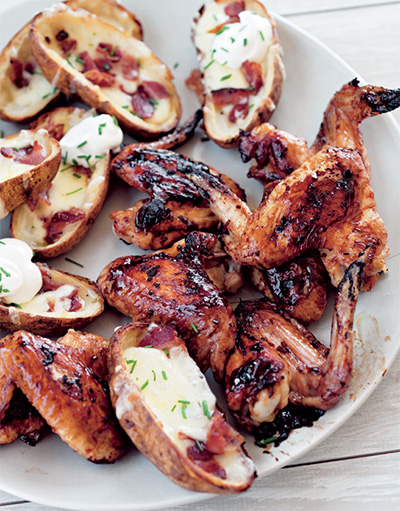
Loaded Potato Skins (page 123) and Teriyaki-Glazed Wings
I’m a wing girl—always have been—and for the longest time that was never a family conflict. With any given roasted whole chicken dinner, there was no dispute: Mom got the wings. But over the years, my family caught on to the skin-crunch-meat-bone wing attributes, and now they all want the wings. So we buy large pallets of them in the grocery store for home cooking. For a straight-up collegiate-style chow-down, serve with Loaded Potato Skins (page 123).
Glaze
⅔ cup low-sodium soy sauce
1⅓ cups sake or dry white wine
¼ cup mirin
One 1-inch piece ginger, peeled and minced
2 garlic cloves, minced
2 tablespoons sugar
2 pounds whole chicken wings
1 tablespoon vegetable oil
½ teaspoon coarse salt
Salty Craving
makes 12 pretzels
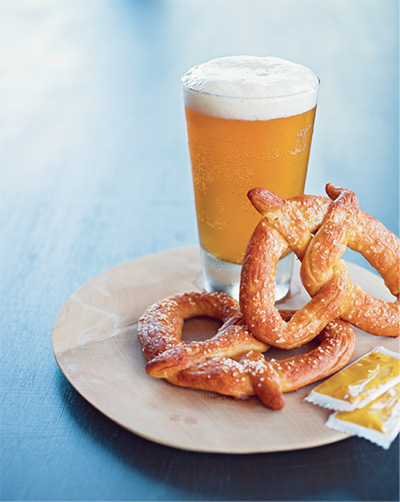
On my very first trip to New York City, the first thing I noticed when I emerged from the train station was the aroma of roasting chestnuts wafting from a vendor’s cart. Also on offer were big, fluffy, salty, doughy pretzels. You can still find the same type of pretzel everywhere on the streets of New York. One pound store-bought bread dough can be used in place of the homemade.
1 cup warm water
2 teaspoons sugar
¼ teaspoon coarse salt
One ¼-ounce package (2¼ teaspoons) active dry yeast
3 cups all-purpose flour, plus more for dusting
2 tablespoons unsalted butter, at room temperature
3 tablespoons baking soda
2 tablespoons pretzel salt or coarse salt
Mustard
Combine the water, sugar, salt, and yeast in a small bowl and let stand for about 5 minutes to dissolve the yeast.
Doughy Deliciousness
serves 4 to 6
This beautiful soft yeast dough is the basis for a Chicago-style deep-dish pizza or what they call a Sicilian in New York City pizza parlors. Basically it’s a thick, doughy, focaccia-like crust instead of the thin, crispy, and chewy variety. This one, baked with one of my favorite toppings of all time—slow-roasted tomatoes—rather than laden with mozzarella, harks back to my grandmother’s house, where she and her sisters embedded this scent and taste memory in my mind. The tomatoes can be made in advance, as can the dough, which needs to rise overnight in the refrigerator. Then simply roll out the dough, let it rest, and assemble the pizza just before baking.
Pizza Dough
1⅓ cups water
1 teaspoon sugar
One ¼-ounce package (2¼ teaspoons) active dry yeast
3 cups plus 1 tablespoon all-purpose flour
¼ cup cornmeal
1 teaspoon coarse salt
¼ cup olive oil, plus more for the bowl
Slow-Roasted Tomatoes (recipe follows)
¼ cup grated Parmesan or Pecorino Romano cheese
makes 24 crisps
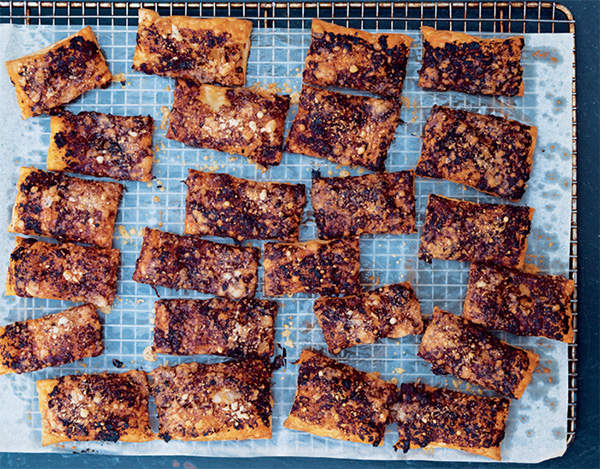
These savory nibbles—inspired by ’wichcraft, a take-out lunch spot near my office—are great appetizers with wine. Or serve them with Classic Tomato Soup (page 61). Using that versatile convenience item, frozen puff pastry, makes them easy to put together. If you can’t find sun-dried tomato paste (see page 23), substitute good-quality regular tomato paste.
3 tablespoons sun-dried tomato paste
1 tablespoon extra virgin olive oil
1 piece store-bought puff pastry (such as a 17.3-ounce package Pepperidge Farm), thawed
½ cup grated Parmesan cheese
¼ teaspoon freshly ground black pepper
makes 18 biscuits
Your only problem with these great biscuits will be the irresistible force drawing you to eat too many, especially when they’re still warm. You can use this good, reliable recipe any time you’re craving a moist and savory drop biscuit. I love to serve these with Butterfield Stageline Chili (page 156), broken up into little pieces and stirred into the bowl. You can also keep them at the ready wrapped in resealable plastic bags in the freezer—reheat in a 275°F oven for 5 minutes, or let defrost at room temperature for 30 minutes before heating in the microwave briefly. Reheated frozen biscuits taste just like fresh-baked.
2 cups all-purpose flour
2 teaspoons baking powder
½ teaspoon baking soda
1 teaspoon sugar
½ teaspoon coarse salt
Pinch of cayenne pepper
6 tablespoons cold unsalted butter, cut into small cubes
6 ounces sharp white or orange cheddar cheese, shredded
1⅓ cups buttermilk (shaken well before measuring)
2 tablespoons chopped fresh chives
Shortcut Impostor
serves 6 to 8
Straight from my grandmother’s recipe file, title and all, these little bites have all the flavor and appeal of an everything bagel, what with the poppy seeds, garlic, and onion. Serve with soups or alongside some cheese for nibbling.
6 English muffins
8 tablespoons (1 stick) unsalted butter, at room temperature
1 garlic clove, minced
1 small onion, minced
1 teaspoon poppy seeds
serves 4
Faced with a choice between French fries and onion rings, my crunchy side will always choose onion rings. Something about onion rings just puts me over the edge—perhaps it’s the crunch of the fried coating surrounding the soft-sweet slivers of onion. Soaking the onions in cold water for 10 minutes will dilute their sulphur content, making them sweeter and milder.
2 large Vidalia or other mild onions, cut into ¼-inch-wide rings
Vegetable oil for deep-frying
1 cup plus 2 tablespoons all-purpose flour
¼ cup cornstarch
2 teaspoons baking powder
1 teaspoon coarse salt, plus more to taste
1⅓ cups ice-cold water
Roll with It
makes 12 rolls
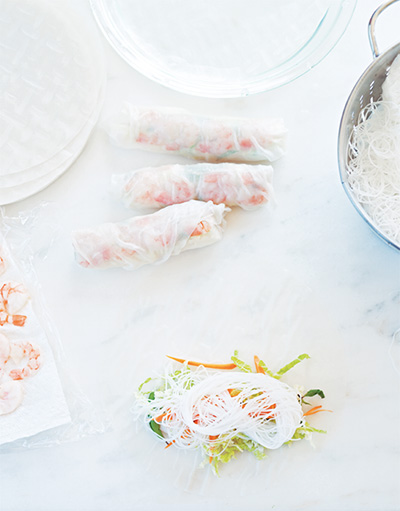
Summer rolls are a healthful way to satisfy an Asian food craving. They are fresh room-temperature rolls, not deep-fried. Here, julienned veggies (see page 83), blanched shrimp, herbs, and thin noodles are wrapped in rice papers and served with a flavorful dipping sauce. Set up an assembly line to make them—it’s a great family activity.
24 medium shrimp (about 1 pound)
Coarse salt
4 ounces rice vermicelli noodles
12 spring roll skins
1 cup fresh Thai basil leaves or Italian basil leaves
1 packed cup finely shredded Napa cabbage
1 medium carrot, peeled and julienned
Dipping Sauce
3 garlic cloves, minced
1 jalapeño, minced
¼ cup chopped palm sugar or packed light brown sugar
Juice of 2 limes (¼ cup)
⅓ cup fish sauce
2 scallions, white and pale green parts minced, dark green tops thinly sliced
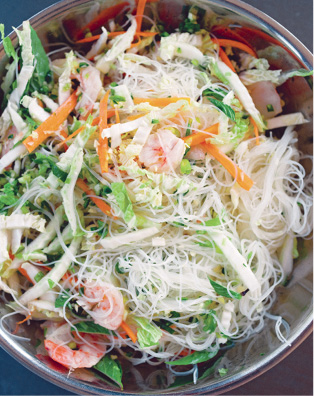
serves 1
My son Calder’s all-time favorite late-night snack is only in need of a small pot of boiling water. He figures that even a single guy who gets home late, when the local pizza joint and corner deli are closed, needs to eat. Starving and desperate—with no options left? This recipe is a clever abbreviated adaptation of the favorite Chinese takeout cold sesame noodles.
One 3-ounce package ramen noodles with flavoring
1 tablespoon soy sauce
2 tablespoons chunky peanut butter
2 teaspoons Sriracha sauce
½ scallion, thinly sliced (optional)
makes 20 skewers; serves 6 to 8
Take your young kids to a Thai restaurant, and one of them is sure to order satay. The marinated meat, whether chicken or beef, is threaded on skewers and grilled, but it’s the creamy peanut sauce that really grabs their attention. These skewers will be a smash hit at your table. Thinly sliced boneless chicken can be substituted for the beef.
¼ cup peanut oil
1 large shallot, minced
2 garlic cloves, minced
One 2-inch piece ginger, peeled and minced
¼ cup low-sodium soy sauce
1 teaspoon turmeric
1 teaspoon ground coriander
¼ cup fresh lime juice
¼ teaspoon freshly ground black pepper
1 pound flank steak, sliced ⅛ inch thick against the grain (see page 68)
Thai Peanut Sauce (recipe follows)
About 20 wooden skewers